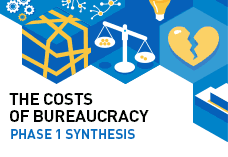New to the MIX? To participate in the Hackathon, please create a MIX account.
Already have a MIX account? Just log in with your MIX username and password.
If you've forgotten your account information or need any assistance, contact us.
WELCOME
Welcome to the “Busting Bureaucracy” Hackathon. Over the next few months, you’ll have the chance to collaborate with other leading thinkers and practitioners from around the world to address a truly pressing challenge:
How can technology enable tomorrow’s winning management practices and “bust” the bureaucracy that stifles most organizations today?
PHASE 1: INITIAL BRAINSTORM
Help kickstart the hackathon by sharing your take on how bureaucracy (i.e., top-down command structures and formal rules and procedures focused on conformance) is stifling your organization’s ability to adapt, innovate, or truly engage its people. To get some context and inspiration, read Gary Hamel's introductory blog and watch his welcome video.





